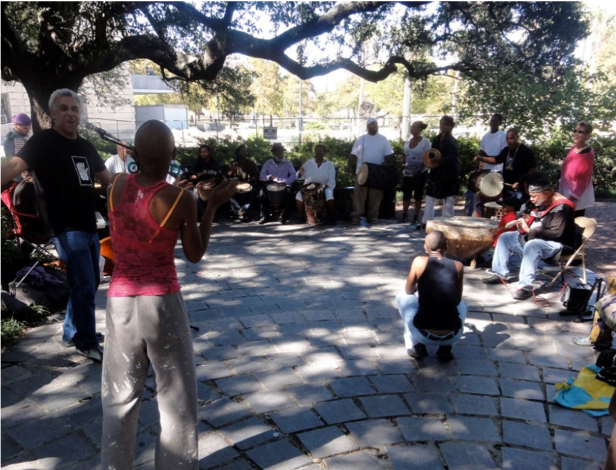The dizzying drum beats, bright, floating tones of a trumpet or sax; the thumping undercurrent of rhythmic bass; the lively bouncing piano – all energized by the improvisatory buzz. This was the sound of one of the United States’ most crucial Cold War weapons:

While for Germans, Kultur refers to high culture, often inaccessible to ordinary people, Americans approach culture differently. In the interest of projecting ‘soft power’ across the pond and even further beyond the Iron Curtain, the U.S. administration has employed various genres of uniquely American music and entertainment to represent American lifestyles and woo Eastern European audiences. Among the most audacious of these strategies was stationing Elvis Presley in West Germany in 1958 as well as sending the famous ‘Jazz Ambassadors,’ such as Louis Armstrong, on tour throughout Europe, the Middle East, and Africa.

The roots of jazz, however, are wildly different from those of rock ‘n’ roll. What made jazz so uniquely American was its origin in a uniquely American experience: that of being a person of color in a slave-owning and profoundly racist nation. Mostly originating from distinctly African musical traditions, jazz emerged in communities of enslaved peoples in New Orleans, where public dances took place in a large open space called Congo Square. Musicians banged rudimentary drums and twanged on self-made string instruments while large crowds bopped in circular directions, all stomping feet, echoing call-and response chants, and swaying to the music’s flow. It was a way for African Americans to musically express their experiences.
A number of mostly African American artists – Dizzy Gillespie, Duke Ellington, Miles Davis, Ella Fitzgerald and, of course, Louis Armstrong – emerged as the genre went mainstream in the early 20thcentury. As white musicians joined the ranks, the genre became emblematic of American diversity and inclusiveness, a significant irony given its origin.
Fast-forward to the Cold War, when jazz became an even more literal emblem of American democratic culture. Not only did it show off the nation’s vibrant music scene, but the carefree style of jazz also countered the repressive regimes of Eastern Europe. Russian governments had long been suspicious of this music, even attempting to ban the saxophone in the 1920s. At the same time, Armstrong and others were ushered abroad to play for wildly enthusiastic international audiences. However, this was not the U.S. government’s only motivation. Picture the America of the day – segregation, voting discrimination, ghettoization. Attempting to portray yourself as the best and fairest country in the world while grappling (poorly, some might argue) with glaring racial inequality isn’t the easiest task. So, from 1955 onwards, Armstrong and his All Stars were sent all over Europe as if to say: Hey, not only do we have a vibrant and liberated musical culture, but we include people of color in it, too!The audiences adored “Satchmo,” much to the Soviet’s dismay.
“Ambassador Satch,” despite remaining mostly silent on political affairs during his career, had a history of criticizing America’s treatment of people of color. In 1957, he cancelled a tour to the Soviet Union over the infamous events at Little Rock Central High School, during which Arkansas Governor Orval Faubus sent out National Guard troops to block nine black students from attending the school. Armstrong was also featured as a character in Dave and Iola Brubeck’s satirical musical on this incident, “The Real Ambassadors.” The lyrics of the opening piece are taken from its titular song, and the message is clear: How can America expect Armstrong to represent it when it refuses to represent him?
Though I represent the government
The government don’t represent
Some policies I’m for!
Oh, we learned to be concerned about the constitutionality,
In our nation, segregation isn’t a legality.
Soon our only differences will be in personality,
That’s what I stand for!
Who’s the real ambassador,
Yes, the real ambassador?
 Nonetheless, Armstrong continued his ‘diplomatic’ work for much of his career. Arguably, one of the biggest cultural moments of the Cold War was his 1965 performance in East Berlin, although he remained mute on all things political, emphasizing that he was primarily concerned about his music.
Nonetheless, Armstrong continued his ‘diplomatic’ work for much of his career. Arguably, one of the biggest cultural moments of the Cold War was his 1965 performance in East Berlin, although he remained mute on all things political, emphasizing that he was primarily concerned about his music.
Maybe that’s a nice way to frame this story – Jazz’s warm energy, its inclusive atmosphere and liberated spirit could be said to represent two historic triumphs: the emancipation of slaves and racial progress in the U.S. and the victory of democratic, liberal ideals over Soviet repression and dogmatism. Maybe this is simply a story of the uniquely redemptive power of music.
21,033 Total Views, 9 Views Today






